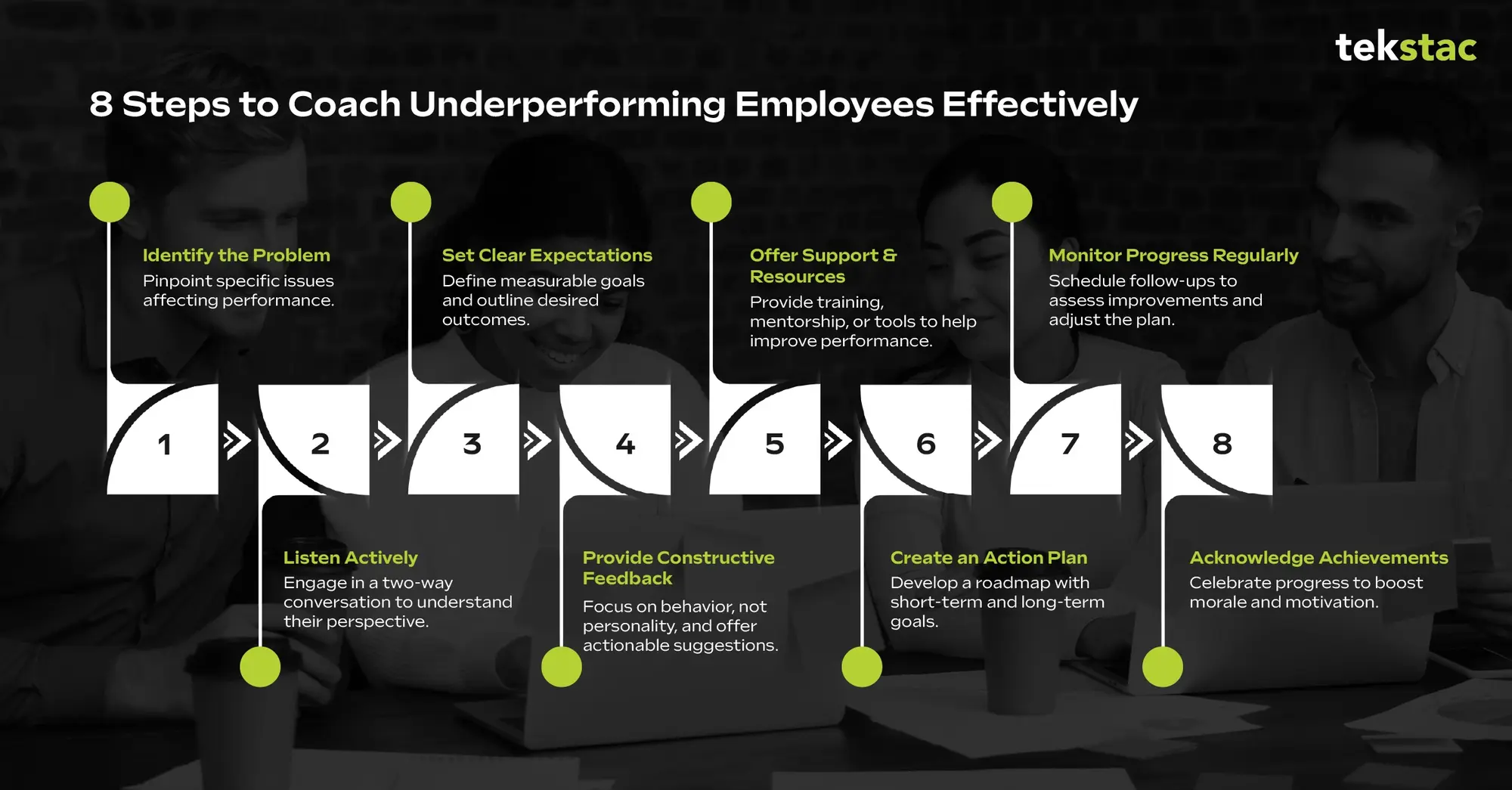10 Effective Strategies for Coaching Underperforming Employees

Coaching employees who struggle to meet expectations is an essential leadership skill that can transform workplace challenges into opportunities for growth. Low-performing employees can impact team dynamics, morale, and productivity, but leaders can turn these situations around with the right approach.
An effective coaching strategy can help employees overcome obstacles, develop skills, and regain confidence.
This article will explore ten practical strategies for coaching underperforming employees, helping you guide them toward success.
Effective Strategies for Coaching Underperforming Employees
A leader’s ability to coach employees struggling to meet expectations is one of their most essential skills. This ability can significantly impact individual and team performance, helping low-performing employees overcome challenges and contribute effectively to the organization.
According to research from Culture Amp, underperforming employees make up an average of 4% of an organization’s workforce. However, this percentage can range from 0% to 20% depending on industry type, organizational culture, and performance evaluation criteria.
An organization that can identify and support these employees will increase both performance and overall productivity, employee engagement, and workplace morale.
Different experts propose strategies to support employees in overcoming challenges and building the confidence necessary to excel in their roles.

1. Identify the Root Cause of Underperformance
To help an underperforming employee, you must first understand what is causing the issue. Once you know why, it’s easier to tailor your approach to suit the individual’s needs; for example, if the problem is a skills gap, consider offering upskilling and reskilling opportunities to ensure the employee has the necessary skills to succeed.
- Surveys or a feedback form can help you discover systemic or individual issues.
- Look for patterns of behavior such as missed deadlines, discouragement to do the work, and struggle to participate.
- Feedback from other team members will help you get a complete picture if you are open to it.
2. Set Clear Expectations and Goals
Clear, measurable goals are essential to guide employees back on track. Goals prevent you and the employee from wondering what is expected and how success is measured.
- Performance reviews are a means to discuss and set short-term and long-term goals.
- Make your bigger goals more actionable, and more manageable.
- Make sure the goals fit the role and that they move the career forward.
3. Provide Regular and Constructive Feedback
Coaching is generative, and feedback is a powerful tool. Employees struggling to meet expectations greatly benefit from regular and constructive feedback, which helps them identify areas of improvement and take corrective action. Supporting low-performing employees with clear guidance can drive meaningful progress and growth.
Managers can play a crucial role when employees face a skills gap by offering targeted feedback and support to help bridge the gap effectively. This guide lists the most critical skills gaps employers prioritize in 2025 and provides actionable strategies for addressing them.
- Feedback after observing behavior should occur soon.
- Don’t use language that judges; think about what can be improved.
- Ask employees for their perspective on feedback make it a two-way conversation.
4. Offer Additional Training and Development Opportunities
At times, those who underperform fail to have the skills or knowledge. Training and development opportunities boost morale and bridge the skills gap in employees, and over time, they can boost performance. This training could take the form of formal classes, online sessions, mentoring, or hands-on workshops.
- State-specific skills the employee needs to develop.
- Have someone to do the learning with (a mentor or peer) to trigger more learning.
- Support the development of their career.
5. Foster a Supportive and Positive Work Environment
Better employee performance is a function of a supportive work environment. When employees are given value, respect, and support they are able to overcome obstacles and are more likely to perform at their best.
- Promote team collaboration and open communication.
- Reward small wins because you must recognize and celebrate them to gain morale.
- Celebrate strengths rather than weaknesses.
6. Break Tasks into Manageable Steps
Employees facing performance challenges may procrastinate or feel overwhelmed by large tasks or projects. Breaking these tasks into smaller, more manageable steps can reduce stress, clarify priorities, and foster a sense of achievement with each completed step.
- Divide large projects into smaller, attainable milestones.
- If you need to catch up with tasks, plan for regular check-ins.
- Maintain your motivation and confidence by celebrating each milestone.
7. Motivate Through Positive Reinforcement
One of the most powerful ways to increase performance is by motivating employees through positive reinforcement. Verbal or tangible rewards are only two forms of motivation out of many.
- In team meetings or via email, publicly acknowledge achievements.
- Let’s praise effort as well as outcome, not final results only.
- Ask employees to consider within themselves what they have improved upon.
8. Align Responsibilities with Strengths
Every employee has their strengths to help them succeed. You can achieve better performance by aligning your tasks and responsibilities with the strengths.
- Find out the employee’s essential strengths and interest areas.
- Reassign them to tasks or projects that better suit their skills.
- Check-in regularly to see if the employee has confidence in their role.
9. Encourage Ownership and Accountability
Empowering employees to own their work is one way to improve performance. Accountability creates a feeling of responsibility and motivates people to reach their full potential.
- The expectation for each task and its included responsibilities is set.
- Allow employees to think and act for themselves.
- You should hold employees responsible at the individual level accountable for their actions and the results they create.
10. Know When to Offer Additional Support or Make Tough Decisions
Sometimes, coaching will help resolve underperformance; sometimes, it won’t. If an employee’s performance doesn’t improve after coaching, you may need to use a performance improvement plan (PIP) or other alternatives.
- Coaching or mentoring (extended tenure) if work performance doesn’t improve.
- Offer additional support through professional counseling or employee assistance programs.
- If necessary, consider tough reassignment or separation while being fair and transparent.
Conclusion
Coaching employees struggling to meet performance expectations requires patience, a commitment to understanding their challenges, and the skill to develop effective solutions.
Remember that there are reasons the team underperforms, and fixing them early on will do wonders for keeping the team productive and in a reasonable frame of mind. By continually adapting and changing your coaching methods to suit the needs of your employees, you will simultaneously see performance and satisfaction improve.
What strategies have worked for you when coaching underperforming employees? Share your tips, experiences, or insights in the comments below! If you’re looking for leadership and employee development support, consider checking out Tekstac.





